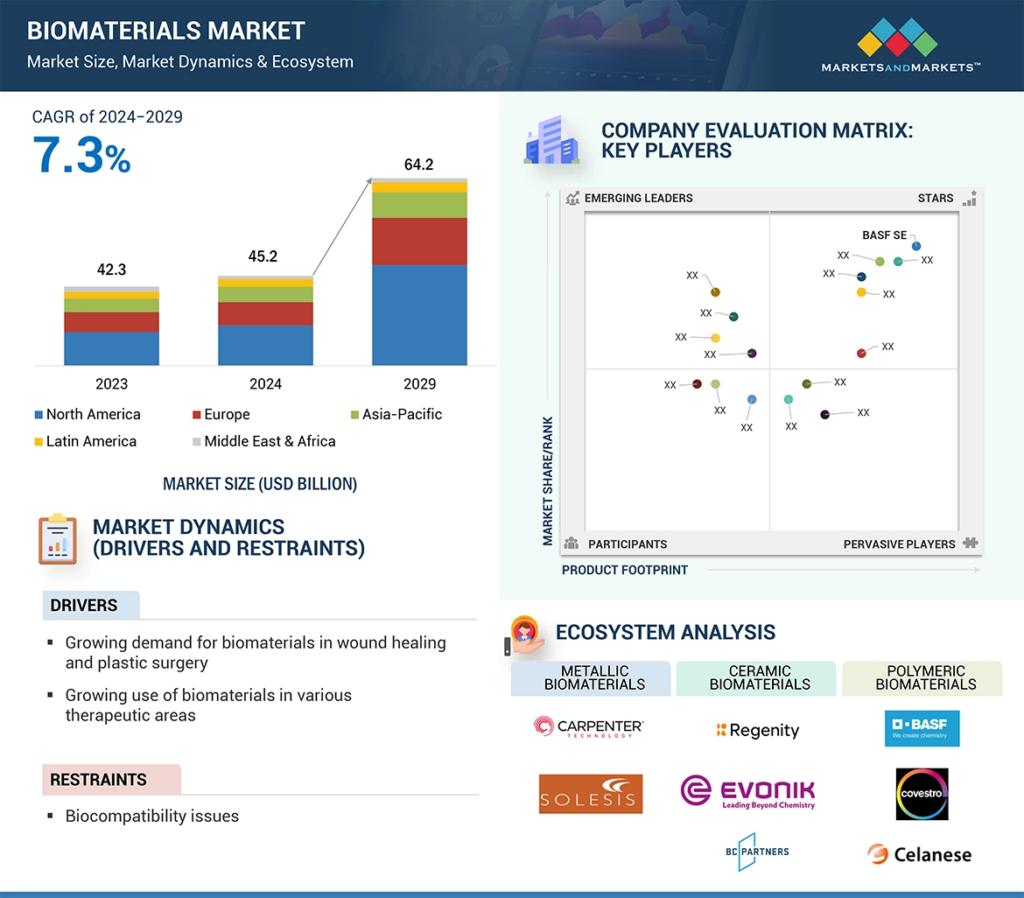The global biomaterials market is experiencing significant growth, driven by advancements in medical technology, an aging population, and increased applications across various medical fields. As of 2024, the market is valued at approximately $45.2 billion and is projected to reach $64.2 billion by 2029, reflecting a compound annual growth rate (CAGR) of 7.3%.
Download PDF Brochure: https://www.marketsandmarkets.com/pdfdownloadNew.asp?id=393

Key Market Drivers
- Advancements in Medical Technology: Continuous innovations have led to the development of new and improved biomaterials that enhance patient outcomes. These advancements have expanded the applications of biomaterials in areas such as cardiovascular, orthopedic, and dental treatments.
- Aging Population: The increasing global elderly population has led to a higher incidence of age-related conditions, such as osteoarthritis and cardiovascular diseases, which often require interventions involving biomaterials. This demographic trend is a significant driver for market growth.
- Rising Demand in Plastic Surgery and Wound Healing: Biomaterials are extensively used in plastic surgery to reconstruct and repair soft tissue wounds, burns, and other injuries. Their natural and safe integration into the human body makes them ideal for these applications.
Market Segmentation
The biomaterials market is categorized based on type and application:
- By Type:
- Metallic Biomaterials: Including stainless steel, titanium, and cobalt-chrome alloys, these materials are widely used in orthopedic and dental implants due to their strength and biocompatibility.
- Polymeric Biomaterials: Materials such as polymethylmethacrylate and polyethylene are utilized in various applications, including contact lenses and drug delivery systems.
- Ceramic Biomaterials: Comprising calcium phosphate and zirconia, ceramics are primarily used in dental and orthopedic applications for their hardness and wear resistance.
- Natural Biomaterials: Substances like hyaluronic acid, collagen, and gelatin are employed in wound healing and tissue engineering due to their biocompatibility and bioactivity.
- By Application:
- Cardiovascular: Biomaterials are used in stents, heart valves, and vascular grafts to treat various cardiovascular conditions.
- Orthopedic: Incorporation in joint replacements, bone grafts, and fracture fixation devices.
- Dental: Utilization in dental implants and tissue regeneration procedures.
- Plastic Surgery: Application in reconstructive procedures and cosmetic enhancements.
- Wound Healing: Use in dressings and scaffolds to promote tissue regeneration.
Regional Insights
North America currently holds the largest share of the biomaterials market, attributed to advanced healthcare infrastructure, significant investments in research and development, and a high prevalence of chronic diseases. The Asia-Pacific region is anticipated to exhibit the highest growth rate, driven by improving healthcare facilities, increasing medical tourism, and rising awareness about biomaterial applications.
Request Sample Report: https://www.marketsandmarkets.com/requestsampleNew.asp?id=393
Challenges
Despite the positive outlook, the market faces challenges such as biocompatibility issues, which can lead to adverse immune responses. Additionally, stringent regulatory frameworks governing the approval and commercialization of medical devices can delay product launches and increase development costs.
Growth Opportunities
- Emergence of Bio-Absorbable Biomaterials: There is a growing interest in bio-absorbable materials that can be gradually absorbed by the body, eliminating the need for additional surgical removal procedures. This innovation is particularly beneficial in orthopedic and cardiovascular applications.
- Expansion in Emerging Markets: Developing countries are witnessing improvements in healthcare infrastructure and increased healthcare spending, creating a favorable environment for the adoption of advanced biomaterials. Companies can capitalize on these opportunities by expanding their presence in these regions through strategic partnerships and localized product offerings.
- Integration with Advanced Technologies: Combining biomaterials with technologies such as 3D printing and nanotechnology can lead to the development of personalized medical solutions, enhancing treatment efficacy and patient satisfaction.
Conclusion
The biomaterials market is poised for substantial growth, driven by technological advancements, demographic shifts, and expanding applications in the medical field. By addressing current challenges and leveraging emerging opportunities, industry stakeholders can significantly contribute to the advancement of healthcare solutions and achieve sustained success in this dynamic market.


